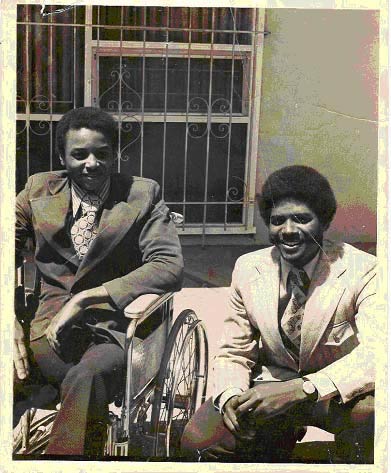
Photo provided by Leroy Moore.
Black Americans in the civil rights movement have had a significant influence on America’s disability rights movement, with some playing crucial roles in both efforts. Much of the progress we have made as a nation achieving positive change for historically marginalized people and communities has been led by Black Americans with disabilities.
As highlighted last year in a New York Times article and the award-winning documentary Crip Camp, one such figure was Brad Lomax. Originally from Philadelphia, Lomax was a civil rights activist in Washington, D.C. in the late 1960s and early 1970s, when he was a Howard University student. But his more lasting legacy stems from his later work advocating for increased equity and inclusion for another marginalized population.
During college, Lomax was diagnosed with multiple sclerosis and began using a wheelchair. Like many other people with disabilities at the time, he found that most public buildings and transit systems were inaccessible to him. When he relocated to Oakland, California, Lomax found a thriving disability rights movement — and another personal calling.
In addition to helping establish a new Center for Independent Living branch in East Oakland, he was instrumental in the historic 1977 sit-in at the San Francisco Federal Building, which resulted in the signing of regulations implementing Section 504 of the Rehabilitation Act of 1973. Modeled after the Civil Rights Act of 1964, Section 504 prohibits discrimination based on disability in any program or activity receiving federal financial assistance, such as education or employment services. Its implementation marked a significant milestone along the way to the Americans with Disabilities Act of 1990.
I’m moved by Lomax’s story because, in addition to our both being graduates of one of the Historically Black Colleges and Universities (I graduated from Morgan State University), his activism indirectly paved my career path. Before joining the Department’s Office of Disability Employment Policy, I worked at the Department’s Office of Federal Contract Compliance Programs. I was part of a nationwide team dedicated to ensuring employers doing business with the federal government did not discriminate against qualified individuals based on race, disability and many other factors. Earlier in my career, I also worked on social justice issues at the U.S. Department of Justice.
I joined ODEP because I wanted to work on policy, but the larger thread running through my work remains consistent: to increase equity and inclusion in our nation’s workplaces and communities. I’m proud to be part of the team at ODEP charged with developing and influencing policies and practices that increase employment opportunities for all people with disabilities, including Black Americans with disabilities.
This is critical to achieving our mission because Black Americans experience higher rates of both disabilities and unemployment. According to the Bureau of Labor Statistics’ Current Population Survey, in 2020, the rate of disability among Black Americans was 13.0% compared with 11.6% for all other races, and the employment rate for working-age Black Americans with disabilities was 20.5% compared with 31.3% for individuals with disabilities of all other races.
In undertaking this vital task, we honor the Black American leaders like Brad Lomax whose own intersectionality propelled him to advance equity and inclusion for all Americans. Even more importantly, we strive to strengthen the connections he forged for generations to come.
Nakisha Pugh is a senior policy advisor in the Department of Labor’s Office of Disability Employment Policy.

 U.S. Department of Labor Blog
U.S. Department of Labor Blog